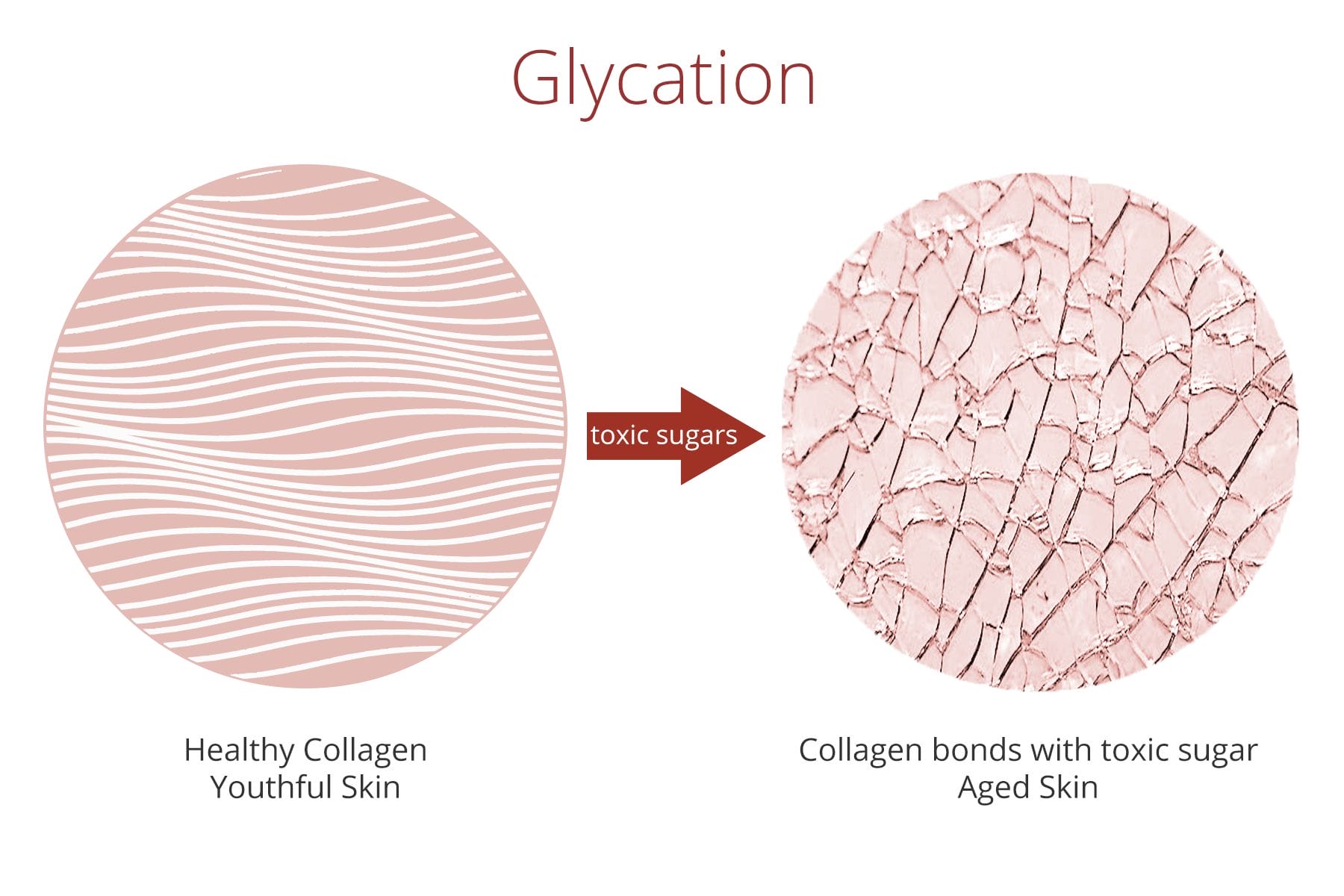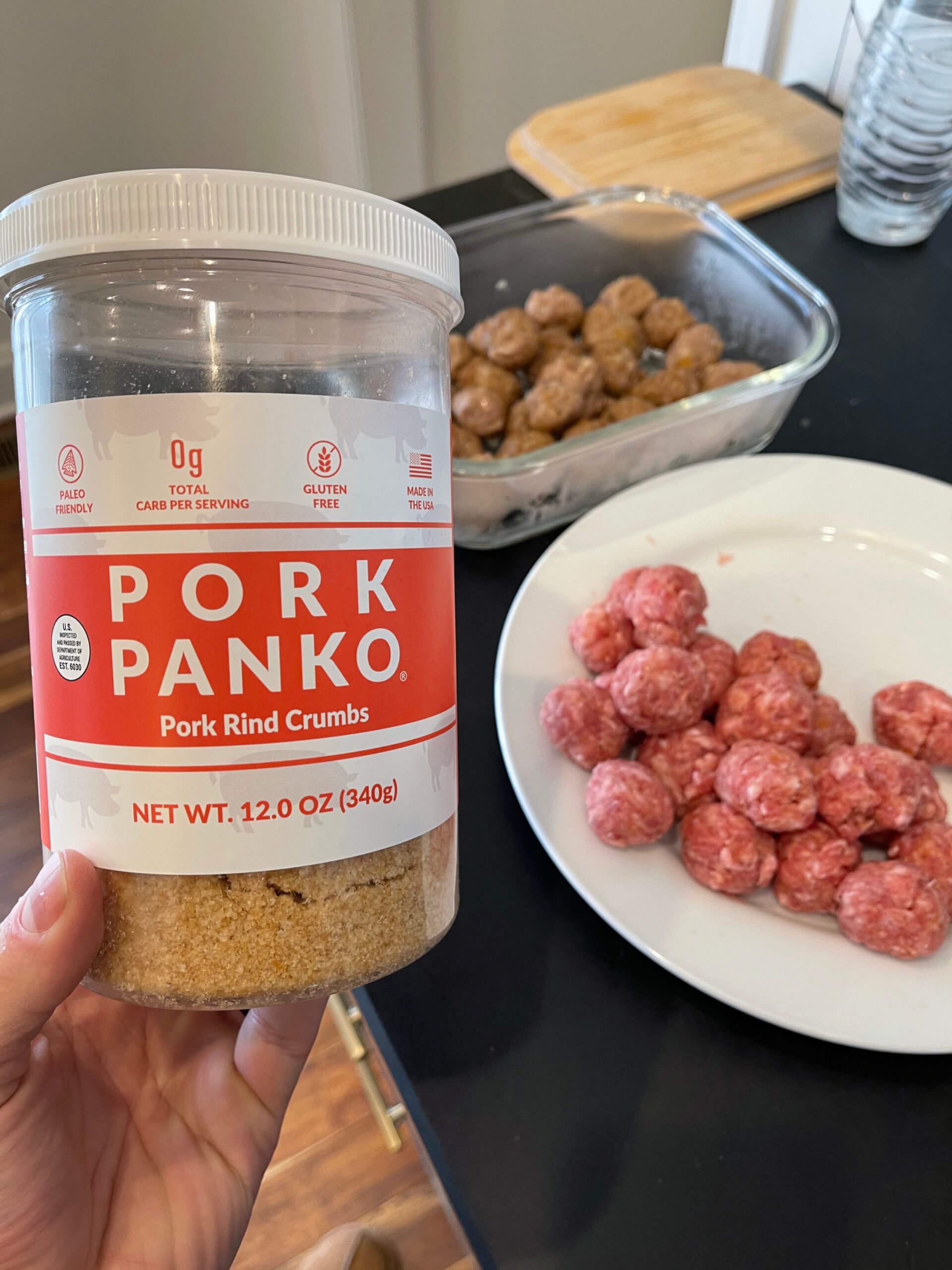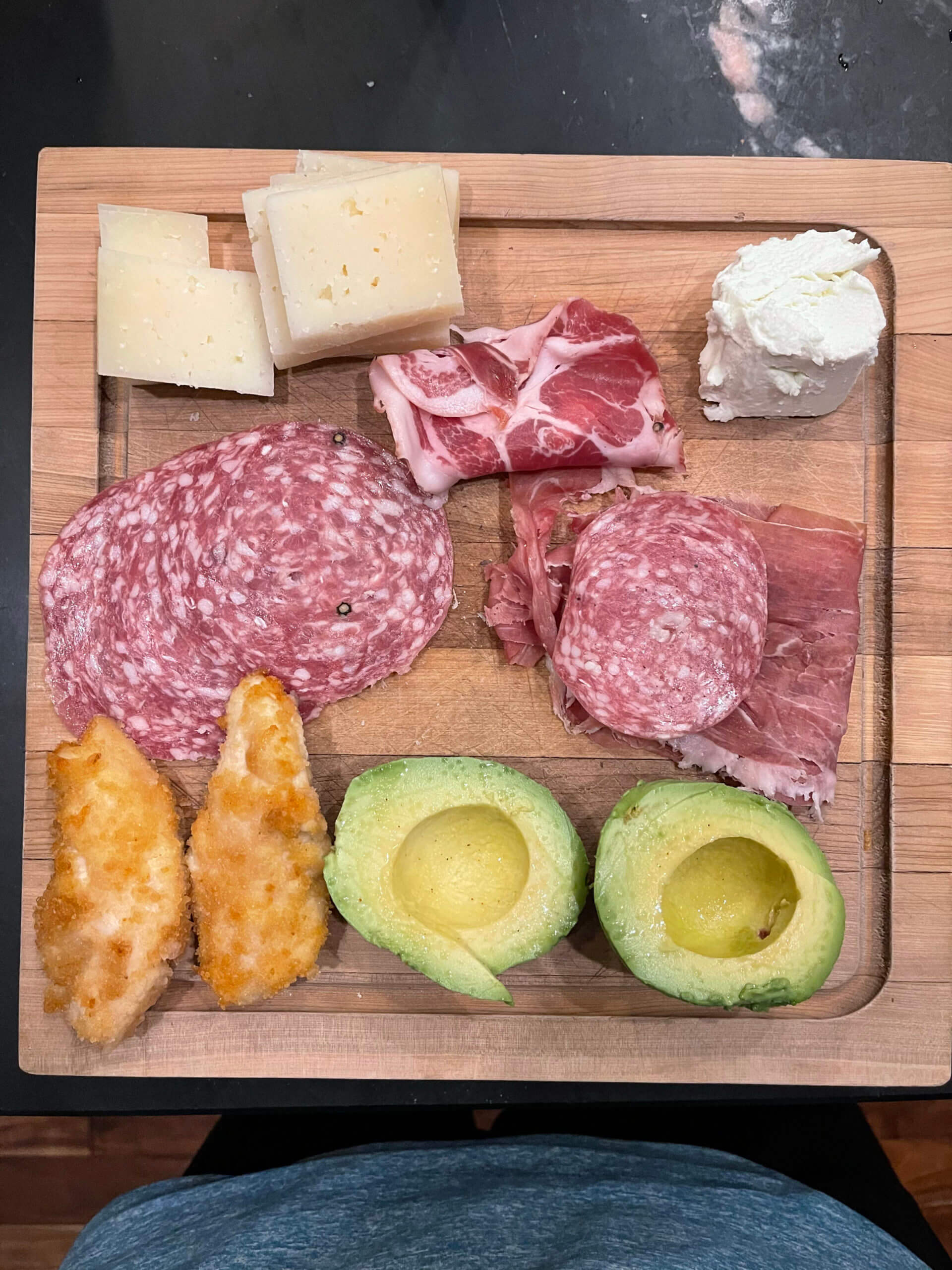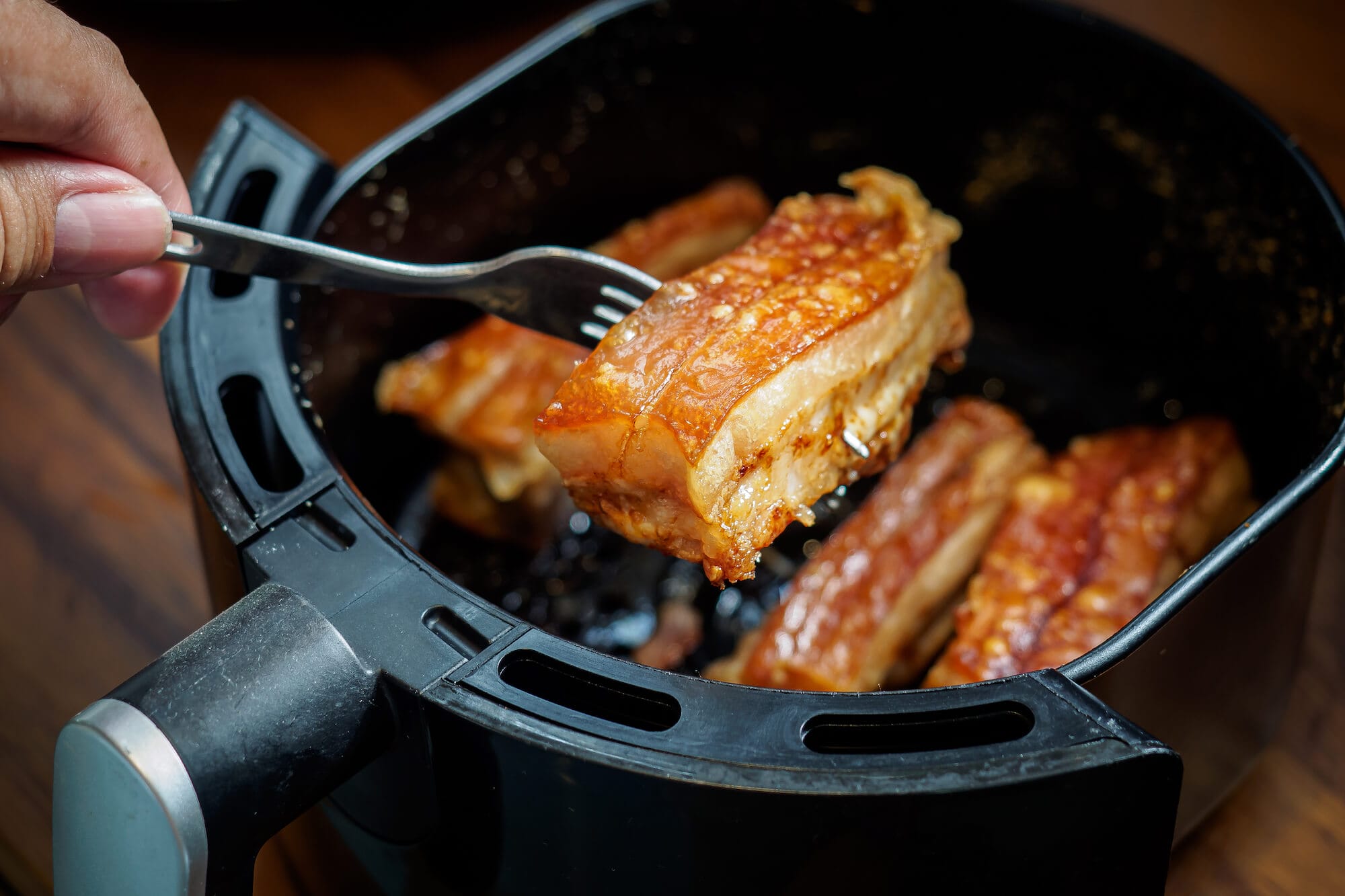Air fryers are marketed as a healthier alternative to deep frying. And while they’ve been gaining in popularity for a few years, it wasn’t until the end of 2020 that I got my hands on one to find out what the hype was all about.
In this article, I’ll talk about the real reasons why air frying can be a healthier approach to deep frying, and I’ll share some details about the air fryer we use at the Kummer household.
Air Frying vs. Deep Frying Misconceptions

Many people think that air frying is healthier than deep frying because it requires much less fat (oil) than a traditional deep fryer. The misconception is that less fat and fewer calories make for a healthier meal.
Unfortunately, that’s not exactly how it works, despite what you might have heard from your nutritionist or doctor.
While eating a low-fat diet might work for some people, there is plenty of evidence that high-fat diets (such as the ketogenic diet) lead to improved health outcomes, including lower cardiovascular risk factors and obesity rates.
Plus, this way of eating mimics how our ancestors and early humans ate for millions of years.
It’s anecdotal evidence, but I’ve been on a high-fat diet for several years and I’m in excellent metabolic health both as indicated by how I look and feel and by regular, detailed blood tests and body scans to check for arterial plague.
So what’s the problem with deep frying, if not the fat?
It’s twofold:
- Most people use seed and vegetable oils when frying food, such as peanut or canola oil. These industrial oils are high in unstable and inflammatory unsaturated fatty acids, such as omega-6.
- Heating carbohydrates together with fat or protein leads to the formation of advanced glycation end products (more commonly referred to as AGEs).
To learn more about why you should ban seed and vegetable oils from your kitchen, check out my article on the problems associated with seed oils.
In a nutshell, vegetable oils (which are actually seed oils) were used as lubricants for industrial machines before someone discovered that they can also be used as cheap cooking oils.
The problem with those oils is that they’re high in polyunsaturated fatty acids (PUFAs). Those are long fat molecules that easily break apart (oxidize) when exposed to air or high temperatures. When they oxidize, they become inflammatory and wreak havoc in our bodies by damaging DNA and impairing normal metabolism.
As I wrote in my article about the dangers of PUFAs, the rate of metabolic disease in the United States has dramatically increased over the past 100 years at the same rate as the consumption of “heart-healthy” vegetable oils has increased. So my recommendation is to banish those oils from your kitchen and use saturated and monounsaturated fats instead.
But pro-inflammatory cooking oils aren’t the only issues with deep frying…
Advanced Glycation End Products (AGEs)

Of the two reasons why deep frying can be unhealthy, the second is complex and requires a bit more explanation.
In general, glycation end products form when certain types of sugars (glucose, fructose and their derivatives) attach or bond with protein or fat molecules that convert to acrylamide and other Maillard reaction products (MRPs).
The problem with AGEs is that they’re known to increase oxidative stress and inflammation in your body.
So how does deep frying contribute to glycation?
In a nutshell, when you fry certain foods that are high in carbohydrates (such as french fries), the starches in those foods convert to sugar and then form bonds with the fat molecules of the frying oil.
The same can happen when baking your fries or pan-frying food that’s rich in carbs, but the problem is exacerbated when deep frying because of the high amount of fat that’s typically used (i.e., because of the oil used for the cooking process).
As a result, the only way to make healthy meals in a deep-fryer is to use foods that are devoid of carbs (such as chicken wings without a sugary sauce) and to use the right type of cooking oil, including tallow, ghee or high-quality olive oil.
Health Benefits of Air Frying

Based on the information above, it makes sense that air frying can be a healthier cooking method than deep frying, because it uses less oil (if any at all). Instead of hot oil, hot air is what heats the food inside the air fryer.
However, it’s worth noting that while fries made in an air fryer have significantly lower amounts of AGEs, they’re still loaded with carbs that can cause a significant spike in blood sugar in most people.
As you might know, consistently high blood glucose levels are associated with an increased risk of insulin resistance, leading to Type 2 diabetes and a host of other metabolic diseases, including heart disease.
So “healthier” doesn’t necessarily mean “healthy” — which is why you should limit your intake of starchy foods (such as sweet potato fries) even if you prepare them in an air fryer.
Additionally, cooking meat in an air fryer instead of on a grill reduces the creation of carcinogens, such as heterocyclic amines (HCAs) and polycyclic aromatic hydrocarbons (PAHs). That’s because air fryers use lower temperatures than most grills and thus are less likely to burn the meat.
However, considering that humans have been cooking food over open flames since the discovery of fire, I’m not convinced that HCAs and PAHs are a problem in the context of grilling a grass-fed steak or burger patty.
When Air Frying Is Not Healthier
As a rule, I don’t recommend using an air fryer to prepare low-fat meat or to reduce your intake of healthy fats because I consider that a misguided dietary strategy.
For example, frying pasture-raised bacon made from pigs that were fed a corn-free and soy-free diet in an air fryer because it allows most of the fat to run off doesn’t make sense, because you should be eating that fat.
Note that the fat of monogastric animals is usually high in pro-inflammatory omega-6 fatty acids, including linoleic acid. The problem is exacerbated if the animal was fed a diet rich in corn or soy (both are also rich sources of omega-6).
After all, animal fat is an excellent source of fuel and essential fatty acids, and the myth that its consumption raises blood cholesterol levels has long been debunked (as I explained in my article comparing saturated with polyunsaturated fats).
We’ve fried bacon in our air fryer, but only because it’s less messy and we can easily pour the fat (from the fryer’s food basket) back into our meal. The goal should not be to avoid fat, unless there’s a risk of glycation due to carbohydrates, or because it came from poorly-raised animals.
Materials and Toxicity of Ceramic Coated Baskets
A lot of kitchenware uses non-stick coatings such as Teflon, which contain toxins, including endocrine-disrupting chemicals.
As you might know, Teflon used to be incredibly popular — until scientists discovered that it can release perfluorooctanoic acid (PFOA) and other toxic chemicals that have been associated with an increased risk of developing cancer.
That’s one of the reasons why we only use stainless steel and cast iron cookware in our kitchen, and why we got rid of all our non-stick pots and pans.
As a result, I was very skeptical when I read that the air fryer we purchased had a Teflon-like ceramic coating in the food basket. So I did some research to figure out the exact coating Kyvol (the brand of air fryer we purchased) uses.
Fortunately, I learned that they use a coating called Fusion, which is made by Whitford and doesn’t include PFOA or polytetrafluoroethylene (PTFE), another toxic chemical that’s frequently used in non-stick cookware.
Additionally, I found an in-vitro study that concluded that “sol-gel” coatings, such as Fusion, aren’t toxic and have no genotoxic or estrogenic properties.
In other words, they don’t leach DNA-damaging or endocrine-disrupting chemicals into food.
While that’s good news, I remain a bit skeptical because I’ve learned that it’s often only a matter of time until we realize that a man-made compound is detrimental to our health.
For now, I accept that there might be an unknown risk and I’ll keep an eye out for future research on this topic.
If you’re in the market for an air fryer, I recommend getting one that either doesn’t use a non-stick coating inside the food basket (if a product like that exists), or one that uses a non-toxic coating like the Kyvol AF60.
How We Use Our Air Fryer


We don’t have a microwave or a steam oven in our current home, and we usually heat up meals on the stove using one of our favorite cast iron pans. While that’s been working really well, we now sometimes use the air fryer to reheat food that could easily overcook, such as meat.
The beauty of reheating food with the air fryer is that it usually takes only five minutes or less and it’s an entirely hands-off process.
Besides reheating food, we also use the air fryer for (occasionally) making sweet potato fries, for frying bacon when we run out of space on our gas stove (e.g., when preparing breakfast for the whole family on Sundays), or for making panko-breaded chicken nuggets.
The one thing we really want to do in the future, but haven’t had a chance to do yet, is to use the air fryer to dehydrate berries (and maybe to make beef jerky). We’ll tackle that after the next growing season in the fall.
Update: As of late 2022, we’ve mostly stopped using our air fryer in favor of the Brava, a countertop smart oven that that can cook almost anything to perfection (including meat and pasture raised eggs). It’s significantly more expensive than most air fryers, but considerably more versatile. Learn more about why we love it in my Brava oven review.
Frequently Asked Questions
Not necessarily. You shouldn’t throw unhealthy types of food (e.g., a slice of Papa John’s pizza) into an air fryer and expect it to turn into a health food. However, air frying can be an excellent choice to make sure naturally healthy food (like a piece of meat) stays healthy, instead of deep frying it in inflammatory seed oils.
That depends on the type of food you want to prepare. For any food that contains carbohydrates (e.g., veggies), low-heat cooking is healthier than using high heat because it avoids the formation of advanced glycation end products (AGEs).
Using low heat also retains more of the micronutrients, including vitamins and minerals. As a result, I’d argue that a steam oven that uses lower temperature settings than an air fryer is the healthier option.
I don’t think air frying is generally healthier than baking. However, the glycemic index (GI) of certain foods (like sweet potatoes) often goes up the longer you expose them to heat. As a result, the potentially shorter cooking time in an air fryer may lead to a lower GI, compared to baking. The lower the GI, the less of a blood sugar spike you’ll experience.
No. It would be a stretch to consider French fries healthy, regardless of their preparation method. However, by air frying fries instead of deep frying them in harmful seed oils, you can make them healthier than regular French fries.
Whether or not a deep fryer makes healthy food depends on what you cook in it. If you use healthy (saturated) animal fats to deep fry chicken wings from 100% pastured-raised hens, you get a perfectly healthy meal. However, if you use harmful seed oils to fry starchy foods, it’s an entirely different story.
It takes about five minutes to reheat food. To me, that’s super quick. But if you’re used to blasting your food for a minute with microwaves, it might feel like forever.
We got used to “slow cooking” when we had a steam oven in our previous home. So for us, five minutes is fast.
If you’re transitioning to an air fryer from a microwave oven, give it some time to get used to and remember that “slow” in the realm of cooking and eating is usually a good (and healthy) thing.
While you could place heat-resistant food containers into an air fryer, I highly recommend that you never heat plastic containers because they release toxic chemicals into food, which can disrupt your endocrine system (hormones) and/or increase your risk of cancer.
Wrap-Up: Are Air Fryers Healthy?

We’ve come to appreciate air frying as a mess-free and hands-off method of reheating and frying food.
Just the other day, my wife made fried chicken breasts using crushed pork rinds (panko) instead of the traditional (grain-based) breading.
Making them in our Kyvol AF60 was super quick because of the relatively short cooking time, and because we didn’t have to clean up all the grease that would normally cover our stove and countertops after deep frying such foods. Plus, the chicken breasts had a super crispy texture, similar to what you’d get with a deep fryer.
We appreciate that our air fryer is versatile and easy to clean, and that the non-stick food basket doesn’t contain toxic chemicals (at least not that I could identify). So if you’re looking for an air fryer, I’d recommend giving the AF60 a try.
The bottom line is that air frying can be a healthy alternative to deep frying. But as I explained above, it’s not due to the amount of oil used when preparing deep-fried foods.
If you already own an air fryer, I’d love to hear what brand you use and how you like it by leaving me a comment below!

Michael Kummer is a healthy living enthusiast and CrossFit athlete whose goal is to help people achieve optimal health by bridging the gap between ancestral living and the demands of modern society.
Medical Disclaimer
The information shared on this blog is for educational purposes only, is not a substitute for the advice of medical doctors or registered dieticians (which we are not) and should not be used to prevent, diagnose, or treat any condition. Consult with a physician before starting a fitness regimen, adding supplements to your diet, or making other changes that may affect your medications, treatment plan or overall health. MichaelKummer.com and its owner MK Media Group, LLC are not liable for how you use and implement the information shared here, which is based on the opinions of the authors formed after engaging in personal use and research. We recommend products, services, or programs and are sometimes compensated for doing so as affiliates. Please read our Terms and Conditions for further information, including our privacy policy.

Hello Michael,
I use a Ninja 5 setting air fryer. When air frying I use avocado oil in a spray bottle that I will spray on the food when needed, most of the time it is to give it the crisp. If oil is not used then it could get very dry and crusty. I consistently cook my meats in there such as grass-fed ground beef, chicken sausages, salmon, and I make tuna patties. One of the biggest reasons I would lean towards an air-fryer is because I really like fried foods such as fried-chicken and fried-salmon. I would like to hear your health opinion on my fried use of my air-fryer. I usually cut the meat so it looks similar to a tenderloin and I then submerge it in egg (sometimes in milk, honey, lemon, etc. as well), then I will put it in the crumb bowl. In this bowl there is usually some variation of panko and seasonings. I then would put it in the air fryer and spray the avocado oil on the chicken tender. Do you think this use of the air fryer is a healthier method than deep frying it?
Hi Anthony,
considering that you’re frying mostly meats without much carb involvement, I don’t think your way of air-frying is healthier than deep frying. It all depends on the oil you use for either cooking method. Avocado oil can be OK if it’s pure and 100% cold-pressed oil. Most avocado oils are contaminated of mixed with seed oils which renders them unhealthy. To be on the safe side, I’d use grass-fed beef tallow. If you do, either air- or deep-frying is perfectly fine.
Cheers,
Michael